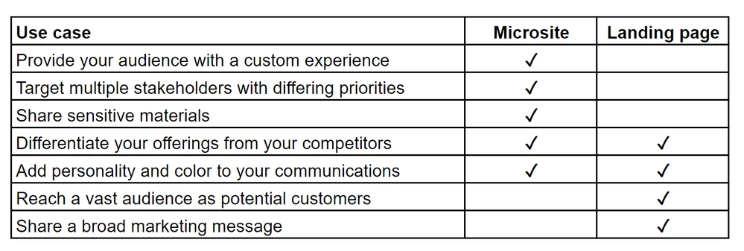The microsite has been getting a lot of attention recently as corporations seek to differentiate themselves from their competitors, add color to their client communications, and gain insights into how their messages are being received.
Not only is a microsite a robust option for proposing your business to a new client, but it can also serve as a resource and touchpoint throughout your work with a new client.
It’s easy to confuse a landing page and its abilities with that of a microsite, but the two offer very different use cases.
Let’s take a deeper dive into the key differences between the two!
What is a microsite
A microsite’s main goal is to build client relationships.
A microsite can be a single page but it can also be multiple pages. These sites are usually hosted on a subdomain (not natively on your own site). Though they can be integrated with your own analytics platforms like Google, you’ll also be able to access in-app analytics to see how clients are interacting.
Perhaps most importantly, a microsite is the safest, most secure way to share commercially sensitive information, which you wouldn’t want available on a landing page. You’d use a microsite to showcase a sales proposal, as a client onboarding portal or as a relationship management hub.
Defining a landing page
A landing page’s main goal is to be used as a marketing tool.
It is usually a single page and it can be added to your own website using a native integration or a variety of third-party apps.
You’d use a landing page if you’re trying to get people to opt-in to a newsletter, get information on potential clients interested in your services or perhaps want to promote a webinar your company is hosting. You wouldn’t want to use a landing page to host a client proposal for example, or a cost analysis report.
Here are some specific use cases for when you’d want to use a Landing Page or a Microsite—or maybe even both.
Microsite vs. landing page

If your client’s needs tick off more boxes under the microsite category, we’ve got good news—we know a guy. And by guy, we mean our platform here at Zoomforth.
Using Zoomforth for creating a microsite
A microsite platform like Zoomforth enables you to create, edit, and administer microsites. There are microsite and landing page options aplenty out there, but here’s what Zoomforth specifically can do for you.
We’re easy to implement
We’re a SaaS app (Software-as-a-Service application) so setup is a breeze. There’s no infrastructure costs or implementation needed as the platform is cloud-based so you can access it from any device in any location.
We do the brand legwork for you
There’s an easy handoff of brand guidelines (fonts, colors, etc) that we build into the site for you. It makes it super easy to implement and get up and running – without a design team’s help. We’ll also create the first design template for you and from there, you’ll be able to, in the words of Fleetwood Mac, go your own way.
We’re a vault
We offer enterprise-level security on our platform, so sensitive information is secure. You’ll rest easy sharing financials and any private information with clients.
We’ve got robust, real-time analytics
Track user engagement in real-time, both at a high level (to inform future content investment) and at a granular level (to enable you to refine your follow up).
As your business’ needs shift more towards offering clients a multipurpose and secure point of contact and a place to view a proposal, content, secure information, and more, a microsite is the hands-down best option for you.
Create interactive, trackable and secure sales proposals with Zoomforth.



